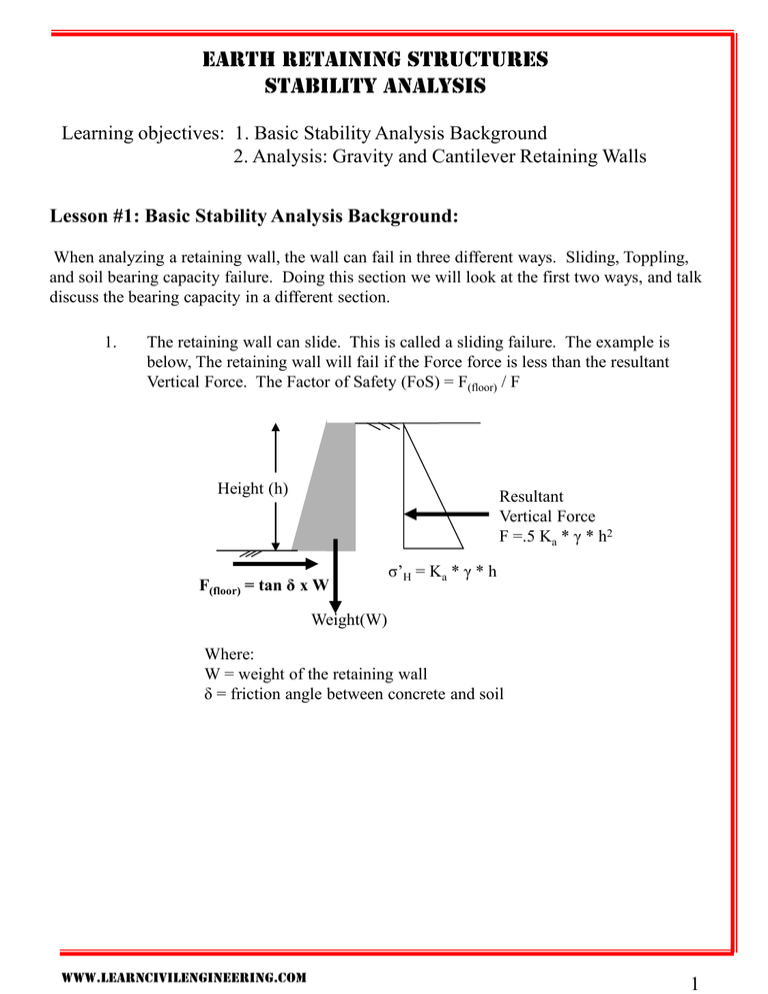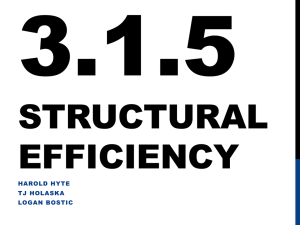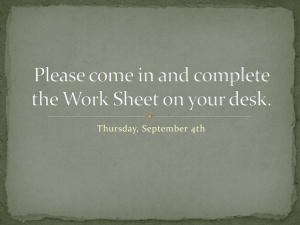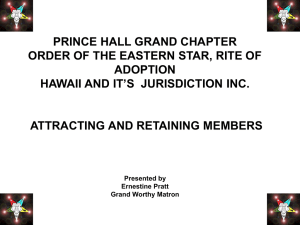Retaining Wall Stability Analysis: Sliding & Overturning
advertisement

Earth retaining structures Stability analysis Learning objectives: 1. Basic Stability Analysis Background 2. Analysis: Gravity and Cantilever Retaining Walls Lesson #1: Basic Stability Analysis Background: When analyzing a retaining wall, the wall can fail in three different ways. Sliding, Toppling, and soil bearing capacity failure. Doing this section we will look at the first two ways, and talk discuss the bearing capacity in a different section. 1. The retaining wall can slide. This is called a sliding failure. The example is below, The retaining wall will fail if the Force force is less than the resultant Vertical Force. The Factor of Safety (FoS) = F(floor) / F Height (h) Resultant Vertical Force F =.5 Ka * γ * h2 F(floor) = tan δ x W σ’H = Ka * γ * h Weight(W) Where: W = weight of the retaining wall δ = friction angle between concrete and soil www.learncivilengineering.com 1 Earth retaining structures Stability analysis 2. The Resistance Against Overturning. The example is below, The retaining wall will fail if the overturning moment (F x (h/3)) is greater than the resisting moment (W x a). The Factor of Safety (FoS) against overturning = resisting moment overturning moment = (3 x W x a) / (F x h) Height (h) PT. A Resultant Vertical Force F = Ka * γ * h2/2 a Weight(W) σ’H = Ka * γ * h Where: a = distance from Pt. A to the center of gravity of weight The best way to explain these stability analysis problems are with examples; Ex. 1: Gravity retaining wall with sand backfill with no groundwater. The height of the retaining wall, h, is 25 ft, the weight of the retaining wall is 60 tons for a 1 ft length of the wall and the weight acts at a distance of 12 ft from the tow of point A. The friction angle of the soil backfill is 30o. The soil backfill mainly consists of sandy soil. The density of the soils is 130 pcf. The friction angle between the soil and earth at the bottom of the retaining wall was found to be 20o. Find the factor of safety for the retaining wall shown above. Step 1: Calculate Ka. Ka = tan2 (45 – φ/2) = tan2 (45 – 30/2) = .33 Step 2: Calculate the horizontal effective stress. σ = Ka γ h = .33 x 130 lbs/cf x 25 ft = 1073 psf Step 3: Find the resultant earth pressure F = σ x (h/2) = 1073 psf x (25ft/2) = 13,413 lbs per foot of wall Step 4: Find the resistance against sliding at the base. FFloor = weight of the wall x tan (δ) = 60 tons 2000 lbs/ton x tan (20) = 43,676 lbs per foot of wall Step 5: Find the Factor of safety for Sliding. The Factor of Safety (FoS) = F(floor) / F = 43,676 / 13,413 = 3.26 FS www.learncivilengineering.com 2 Earth retaining structures Stability analysis Ex. 1 continued: Step 6: Find the resistance against overturning. Resisting moment = W x a = 120,000 lbs x 12 ft = 1,440,000 lbs ft Step 7: Find the overturning moment: Overturning moment = F x H/3 = 13,413 lbs ft x (25/3) = 111,775 lb ft Step 8: Find the FS. Factor of Safety = 1,440,000 lbs ft / 111,775 lbs ft = 12.8 FS So the concern limiting Factor of Safety is the sliding failure which is 3.26. This is still acceptable. www.learncivilengineering.com 3 Earth retaining structures Stability analysis For a cantilever retaining wall system the concept is the same. The retaining can fail by sliding and toppling. However, this system uses the earth weight to help with stability. W3 W2 PT. A W1 Height (h) Passive Resultant Vertical Force F = Kp * γ * h2/2 a F(floor) = tan δ x W σ’H = Ka * γ * h W4 Weight(W) = W1 +W2 +W3 + W4 www.learncivilengineering.com Active Resultant Vertical Force F = Ka * γ * h2/2 Weight from fill Weight from wall 4 Earth retaining structures Stability analysis For the cantilever retaining wall shown below, calculate the factor of factor of safety against toppling? The concrete retaining walls density is 150 pcf. 1 ft 7 ft 3 ft Sand γ = 132 pcf φ = 34° c=0 13 ft 2 ft PT. A 10 ft Step 1: Find what you are trying to solve: W3 W1 FS against toppling: Resisting Moment / Toppling moment W2 Step 2: Find all the forces resisting: All the weight is resisting toppling Weight from fill W1 = 132 pcf (2ft x 2ft) = 528 lbs per lf @ 1 ft Weight from wall W2 = 132 pcf (7ft x 12ft) = 11,088 lbs per lf @ 6.5 ft W3 = 150 pcf (1ft x 12ft) = 1,800 lbs per lf @ 2.5 ft W4 = 150 pcf (1ft x 10ft) = 1,500 lbs per lf @ 5 ft So the moment force resisting due to the weight of the wall and soils F = W1 x d1 + W2 x d2 + W3 x d3 + W4 x d4 = 528 x 1 + 11,088 x 6.5 + 1,800 x 2.5 + 1,500 x 5 = 528 + 72,072 + 4,500 + 7,500 = 84,600 lbs -Also the passive resultant force due to the soil is a force resisting Kp = tan2 (45 + φ/2) = tan2 (45 + 34/2) = 3.5 W4 The resultant force is F = Kp * γ * h2/2 = 3.5 x 132 x 32/2 = 2,079 lbs per lf @ 1 ft So the resisting moment is 84,600 lbs + 2,079 lbs = 86,679 lbs Step 3: Find the toppling moment: Ka = tan2 (45 – φ/2) or 1/Kp = .285 F = Ka * γ * h2/2 = .285 x 132 pcf x 13ft2/2 = 3,179 lbs @ 4.33ft = 13,765 lbs Step 4: Find the Factor of safety: FS = Resisting moment / toppling moment = 86,679 / 13,765 = www.learncivilengineering.com 6.3 5 Earth retaining structures Stability analysis Ex. 3: Below is a gravity retaining wall with sand backfill above the clay layer with no groundwater. The top layer of the backfill is sand with a friction angle of 30 degrees. The density of the sand layer is 130 pcf. The clay layer below the sand layer has a cohesion of 320 psf and a density of 120 pcf. The weight of wall is 40 tons per foot, and the center of gravity is acting 6 ft from the toe of the wall. The friction angle between the concrete and the soil at the bottom of the retaining wall was found to be 25o. Find the factor of safety(tipping and sliding) for the retaining wall. 15 ft Sand γ = 130 pcf φ = 30° Height (h) 12 ft PT. A Clay γ = 120 pcf c = 320 psf 6ft W = 40 tons per ft Step 1: Calculate Ka. Ka = tan2 (45 – φ/2) = tan2 (45 – 30/2) = .33 Step 2: Calculate the horizontal effective stress. Sand layer σ = Ka γ h = .33 x 130 pcf x 15 ft = 644 psf Clay layer @ depth 15 ft from ground level. σ = γ h – 2c = 130 pcf x 15 ft – (2 x 320) = 1310 psf Clay layer @ depth 27 ft from ground level σ = γ h + σ (cl at 15ft) = 120 pcf x 12 ft + 1310 psf = 1440 psf + 1310 psf = 2750 psf Step 3: Find the resultant earth pressure F1 from sand = σ x (h/2) = σ x (15/2) = 644 psf x (15ft/2) = 4,830 lbs per foot of wall F2 from sand on clay = σ x h = 1310 psf x 12 = 15,720 lbs per foot of wall F3 from clay = σ x (h/2) = 1440 psf x (12/2) = 8,640 lbs per foot of wall Total Sliding force = 29,190 lbs per foot of wall Step 4: Find the resistance against sliding at the base. FFloor = weight of the wall x tan (δ) = 40 tons x 2000 lbs/ton x tan (25) = 37,304 lbs per foot of wall Step 5: Find the Factor of safety for Sliding. The Factor of Safety (FoS) = F(floor) / F = 37,304 / 29,190 = 1.28 FS www.learncivilengineering.com 6 Earth retaining structures Stability analysis 15 ft F1 @ 1/3 from bottom Height (h) 12 ft F2 @ 1/2 from bottom F3 @ 1/3 from bottom 6ft PT. A W = 40 tons per ft Ex. 3 continued: Step 6: Find the resistance against overturning. Resisting moment = W x a = 80,000 lbs x 6 ft = 480,000 lbs ft Step 7: Find the overturning moment: Overturning moment = F1 x H/3 = 4,830 lbs ft x (15/3) = 24,150 lb ft Overturning moment = F2 x H/2 = 15,720 lbs ft x (12/2) = 94,320 lb ft Overturning moment = F3 x H/3 = 8,640 lbs ft x (12/3) = 34,560 lb ft Step 8: Find the FS. Factor of Safety = 480,000 lbs ft / (24,150 + 94,560 + 34,560) lbs ft = 480,000 / 153,270 = 3.13 FS So the limiting Factor of Safety of concern is the sliding failure which is 1.28. Which is most likely unacceptable for your design so you would need to add more weight to the gravity retaining wall. www.learncivilengineering.com 7






